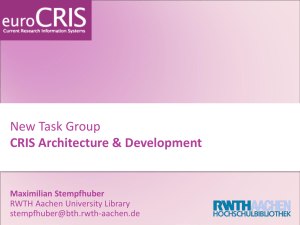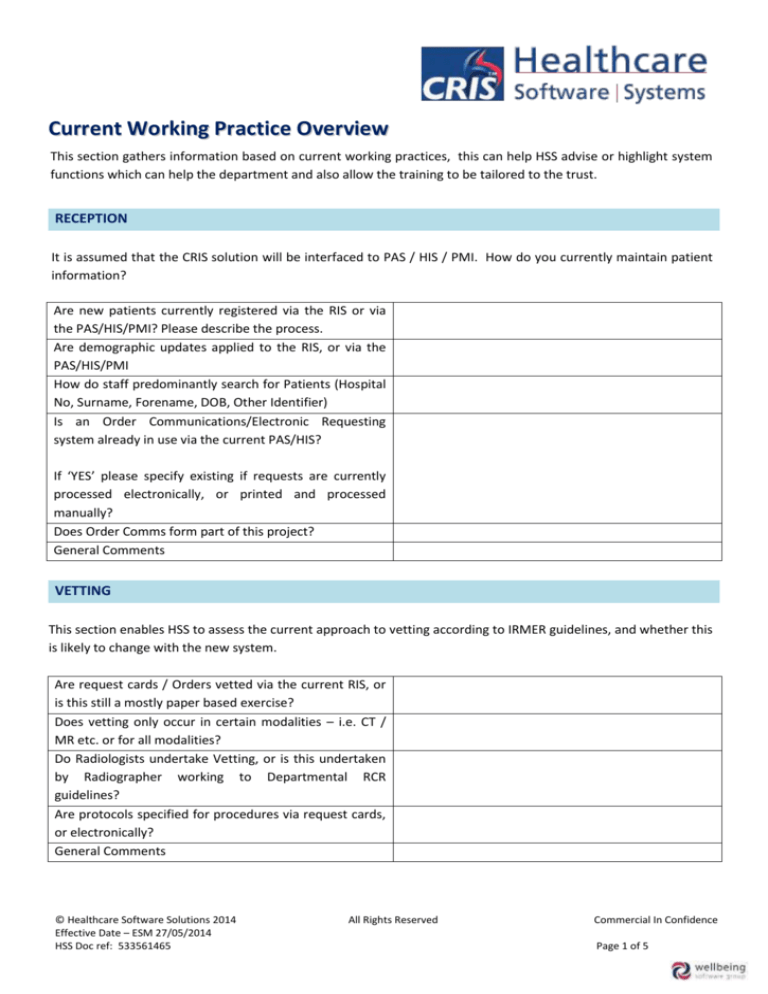
Current Working Practice Overview
This section gathers information based on current working practices, this can help HSS advise or highlight system
functions which can help the department and also allow the training to be tailored to the trust.
RECEPTION
It is assumed that the CRIS solution will be interfaced to PAS / HIS / PMI. How do you currently maintain patient
information?
Are new patients currently registered via the RIS or via
the PAS/HIS/PMI? Please describe the process.
Are demographic updates applied to the RIS, or via the
PAS/HIS/PMI
How do staff predominantly search for Patients (Hospital
No, Surname, Forename, DOB, Other Identifier)
Is an Order Communications/Electronic Requesting
system already in use via the current PAS/HIS?
If ‘YES’ please specify existing if requests are currently
processed electronically, or printed and processed
manually?
Does Order Comms form part of this project?
General Comments
VETTING
This section enables HSS to assess the current approach to vetting according to IRMER guidelines, and whether this
is likely to change with the new system.
Are request cards / Orders vetted via the current RIS, or
is this still a mostly paper based exercise?
Does vetting only occur in certain modalities – i.e. CT /
MR etc. or for all modalities?
Do Radiologists undertake Vetting, or is this undertaken
by Radiographer working to Departmental RCR
guidelines?
Are protocols specified for procedures via request cards,
or electronically?
General Comments
© Healthcare Software Solutions 2014
Effective Date – ESM 27/05/2014
HSS Doc ref: 533561465
All Rights Reserved
Commercial In Confidence
Page 1 of 5
APPOINTMENTS
This section asks generic appointment questions and allows Trusts to describe how they work / envisage working
on CRIS. Its main use is to help the Trainers focus on your working practice but can also stimulate Trusts into
thinking about working practice and system use.
Are Request cards booked onto Waiting Lists / Pending
Lists or so you use a Partial Booking system?
Are Request cards entered into the system upon receipt,
or are they vetted on paper first?
Are appointments booked for all modalities?
Are they put on the system?
Do you book appointments centrally or do patients call to
book upon receipt of a letter?
Are appointments allocated to a specific resource / person
via the current RIS?
How are DNA’s handled?
Are appointments pre-registered prior to the patient’s
arrival? This is not recommended in CRIS.
FILM TRACKING (TYPICALLY LEGACY FUNCTIONALITY)
The solution allows for the tracking for hard copy Film Packets. Each Site can have multiple film packets and
multiple types of packets if required. The solution can also be configured to group sites, where multiple sites
share/file a single film packet.
It is not envisaged that Film Tracking will be required in an existing RIS/PACS scenario but if CRIS will be installed
prior to a PACS going live, the Trust may wish to make use of this feature.
Does the Trust still file and track hard copy?
How are film packets filed at each site?
e.g. by DoB, by Hospital number. Please describe the method(s) at all
sites within your Trust.
Is there one main packet per site.
What packet types do you store? e.g. One main XRAY packet per
person per site, 1 Ultrasound packet per person etc.
Do you use temporary packets. Please describe your processes and
packet types?
Are film packets tracked within the department or just
when they leave the department?
Do existing packets already have barcodes on them?
What does the barcode represent?
e.g. Exsisting RIS patient ID
© Healthcare Software Solutions 2014
Effective Date – ESM 27/05/2014
HSS Doc ref: 533561465
All Rights Reserved
Commercial In Confidence
Page 2 of 5
How and when are new Film packets created?
e.g. A temporary bag is created for every attendance, Main packets are
pulled from store unless a new patient, in which case a new main bag is
created.
POST PROCESSING
The Post Examination (or Radiographers module) is used to capture information about the Examination.
Is relevant processing information about examinations
performed entered onto the system, or handled on paper?
What information is currently recorded? For example:
Examination Room
Radiographer(s) Details
Start Time/End Time of Exam
Contrast Details (Drug): including Batch id, Injected by,
Quantity/Concentration, and Contrast Reaction etc.
Screening time
Examination Dose - Individual views (KVp, mAs) or overall dose?
Type of Film used, number used/rejected, and reject reasons
Stock - such as catheters, stents etc.
CT specific info such as Slices/Disk etc.
Is this information predominantly entered by
radiographers or sonographers, or more often by
radiographic aides?
NUCLEAR MEDICINE
Please note: This section is only applicable if the CRIS Nuclear Medicine Module will be implemented at go-live.
Does the department work from Vials, or are individual
syringes delivered on a daily basis?
Does the department make appointments for patients
electronically, or is this still via paper diaries?
Does the department allocate one appointment time for
the injection/blood sample, and then a separate
appointment time for the examination/procedure itself?
Or alternatively does the department just send out an
appointment asking the patient to arrive for the blood
test/injection, then verbally advise the patient when to
return for the examination/procedure?
© Healthcare Software Solutions 2014
Effective Date – ESM 27/05/2014
HSS Doc ref: 533561465
All Rights Reserved
Commercial In Confidence
Page 3 of 5
CLINICAL REPORTING
Are Clinical Reports dictated using Digital Dictation or
Voice Recognition or a mixture of the two in operation?
If a Digital Dictation/Voice Recognition system is in place:
What type of system is it?
Who is the supplier?
How long has the system been in operation?
Is this a Trust wide system, or is it only in operation at certain
sites?
What patient identifier does the reporting consulting use
when dictating (i.e. Attendance number, Computer/X-ray Number,
Hospital Number etc.)?
Alternatively if PACS Worklists are in use:
Is the process RIS or PACS driven?
Are requests/exams allocated to individuals, or reporting
groups?
Are coded phrases in use, and if so are these phrases
consultant specific?
Are diagnostic or museum coding structures in use (i.e.
ACR, READ, Site-specific etc.)?
Are reports dictated, typed and verified using specific
batch codes?
Do secretaries print reports one at a time as they are
generated, or in a batch at the end, and or following
verification?
Are reports verified electronically or manually verified by
consultants?
Can unverified reports be printed via the existing system?
Is an Obstetrics Ultrasound module in place on the RIS
system? Alternatively, is a separate Maternity ultrasound
system in use, and if what information is cross-referenced
between RIS and the 3rd party system?
Do Sonographers produce their own reports on the RIS
system, or are they typed by secretaries? Alternatively,
are reports generated on paper not the system?
© Healthcare Software Solutions 2014
Effective Date – ESM 27/05/2014
HSS Doc ref: 533561465
All Rights Reserved
Commercial In Confidence
Page 4 of 5
Document Control
Title
Current Working Practice
Author
Emma Savage-Mady
Date Created
23/08/2005
File Ref.
CRIS_TRG_268_Current_Working_Practice_v4.0.doc
CRIS Version 2.09.10p
Change History
Issue
Date
Author / Editor
Details of Change
1.0
23/08/2005
Emma Savage-Mady
1st Issue
2.0
04/12/2012
Emma Savage-Mady
2nd Issue due to update for 2012 and in line with 2.09.10
3.0
19/03/2013
Emma Savage-Mady
3rd Issue due to significant training documentation format
review.
4.0
27/05/2014
Emma Savage-Mady
4.0 issue due to company name change to Healthcare
Software Solutions in addition to on-going documentation
review.
Review Date
27/05/2015
© Healthcare Software Solutions 2014
Effective Date – ESM 27/05/2014
HSS Doc ref: 533561465
All Rights Reserved
Commercial In Confidence
Page 5 of 5

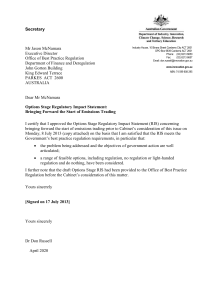
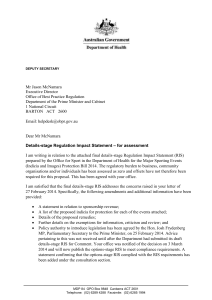

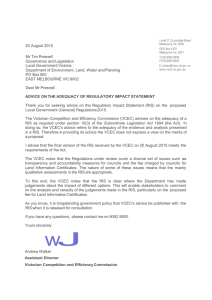
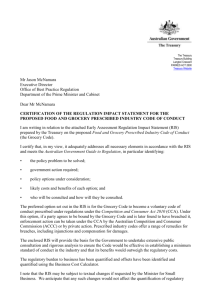
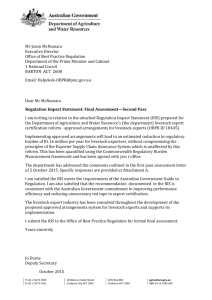
![Appointments: Manual Booking using [ALT-M] in conjunction](http://s3.studylib.net/store/data/007588400_2-a89991296ab31df74067d7b72cd8b787-300x300.png)

